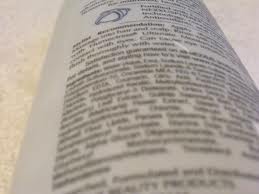
It’s very important to read (and understand) product labels – not only the front but the back where the formal ingredients are listed. Don’t be fooled by the manufacturer’s fancy labels, colors and pictures. Educate yourself before you buy. In the end, it’s about making informed choices based upon your own personal philosophy, understanding and feelings about product ingredients.
Knowledge is key when choosing the best products for your particular hair type and texture.
Below list courtesy of The Curl Whisper
Sulfates
A surfactant—sometimes referred to as a detergent—is a substance that, when dissolved in water, gives a product the ability to remove dirt from surfaces such as the human skin, textiles, and other solids. There are several different types of surfactants, ranging from harsh to mild, with sulfates belonging to the class that is the most harsh.
Common sulfates as found on hair product ingredient bottles include:
- Alkylbenzene Sulfonate
- Ammonium Laureth or Lauryl Sulfate
- Ammonium or Sodium Xylenesulfonate
- Dioctyl Sodium Sulfosuccinate
- Ethyl PEG-15 Cocamine Sulfate
- Sodium C14-16 Olefin Sulfonate
- Sodium Cocoyl Sarcosinate
- Sodium Laureth, Myreth, or Lauryl Sulfate
- Sodium Lauryl Sulfoacetate
- TEA-Dodecylbenzenesulfonate
Some milder surfactants—less drying and recommended in lieu of sulfates—include:
- Cocamidopropyl Betaine
- Coco Betaine
- Cocoamphoacetate
- Cocoamphodipropionate
- Disodium Cocoamphodiacetate or Cocoamphodipropionate
- Lauroamphoacetate
- Sodium Cocoyl Isethionate
Silicones
Silicones generally end in -cone, -conol, -col, or -xane and are found in many hair products. If any silicone name has the abbreviation “PEG” or “PPG” in front of it, however, it is water-soluble and will not build up.
Silicones that are not soluble in water, will consistently build up on the hair and will require a surfactant-based shampoo to remove include:
- Cetearyl Methicone
- Cetyl Dimethicone
- Dimethicone
- Dimethiconol
- Stearyl Dimethicone
Silicones that are not soluble in water, but whose chemical properties allow it to repel further deposit, helping to prevent buildup (although they will still lock moisture out of the hair and require a surfactant to remove):
- Amodimethicone
- Cyclomethicone/Cyclopentasiloxane
- Trimethylsilylamodimethicone
A note about amodimethicone: if you do an Internet search on amodimethicone, you will find quite a few sites that list amodimethicone as a silicone that is “slightly” soluble in water as long as two additional ingredients are included in the formulation: Amodimethicone (and) Trideceth-12 (and) Cetrimonium Chloride (as a mixture in the bottle)
The assumption has always been that the inclusion of Trideceth-12 (a nonionic surfactant) and cetrimonium chloride (a cationic surfactant) render the amodimethicone, non-water soluble on its own, slightly soluble in water and it could be considered okay to use. Turns out that has been a completely incorrect assumption. What the Trideceth-12 and cetrimonium chloride do is render the amodimethicone dispersible in water. Once the amodimethicone is deposited onto the hair shaft and dries to a film, however, it is not water-soluble, will prevent moisture from getting into the hair shaft and will require a surfactant to remove.
Silicones that are slightly soluble in water, but can possibly build up on some types of curly hair over time, include:
- Behenoxy Dimethicone
- Stearoxy Dimethicone
Silicones that are soluble in water and can generally be considered safe to use (in addition to those listed with “PEG” or “PPG” in front of them) include:
- Dimethicone Copolyol
- Hydrolyzed Wheat Protein Hydroxypropyl Polysiloxane
- Lauryl Methicone Copolyol
Proteins
An additional note about proteins: some curly hair types, especially those with a coarse hair texture, are also sensitive to proteins, which can cause some curly hair to become dry and brittle. They are best avoided if any adverse effects are noted.
Common protein ingredients include:
- Collagen
- Hydrolyzed Collagen Protein
- Hydrolyzed Silk Protein
- Hydrolyzed Soy Protein
- Hydrolyzed Wheat Protein
- Keratin
- Keratin Amino Acids
- Silk Amino Acids
- Silk Protein
- Soy Protein
- Wheat Amino Acids
- Wheat Protein
Courtesy of the Curl Whisperer
Remember, do your research and find what ingredients work best for YOUR hair.
More product ingredients (Courtesy of curlynikki.com)
Alcohols
Fatty alcohols provide an emollient effect, and bind water and oil to give our favorite conditioners their slip and creaminess.
Cetyl Alcohol- This is a fatty alcohol that is derived from coconut and palm oils. This alcohol is actually an emollient (makes hair and skin softer).
Stearyl Alcohol- another fatty alcohol. It is nothing like ethanol, it is actually a white solid and is insoluble in water. Stearyl alcohol is often used in conditioners and shampoos and acts as an emollient (softener).
Here’s a list of the ‘okay’ or ‘fatty’ alcohols:
Behenyl alcohol
Cetearyl alcohol
Cetyl alcohol
Isocetyl alcohol
Isostearyl alcohol
Lauryl alcohol
Myristyl alcohol
Stearyl alcohol
C30-50 Alcohols
Lanolin alcohol
Alcohols you should avoid:
Short chain alcohols– SD alcohol, SD alcohol 40, Alcohol denat, Propanol, Propyl alcohol and Isopropyl alcohol.
Humectants
Humectants are included in many hair care product formulations to promote moisture retention within the hair shaft by absorbing water from the atmosphere. Great for humid and/or tropical climates.
Look for the following:
1,2,6 hexanetriol
Butylene Glycol
Dipropylene glycol
Glycerin
Hexylene Glycol
Panthenol
Phytantriol — enhances moisture-retention, increases absorption of vitamins, panthenol, and amino acids into hair shaft, imparts gloss
Propylene glycol
Sodium PCA
Sorbitol
Triethylene glycol
Polyglyceryl sorbitol
Glucose
Fructose
Polydextrose
Potassium PCA
Urea
Hydrogenated Honey
Hyaluronic Acid
Inositol
Hexanediol beeswax
Hexanetriol Beeswax
Hydrolyzed Elastin
Hydrolyzed Collagen
Hydrolyzed Silk
Hydrolyzed Keratin
Erythritol
Capryl glycol
Isoceteth-(3-10, 20, 30)
Isolaureth-(3-10, 20, 30)
Laneth-(5-50)
Laureth-(1-30)
Steareth-(4-20)
Trideceth-(5-50)
courtesy of curlynikki.com
